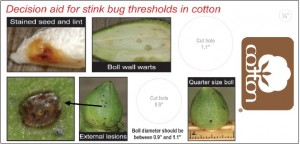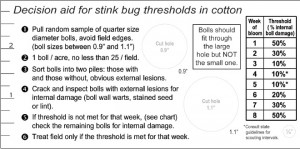 We have a really good cotton crop on our hands in this area, primarily a result of timely planting, good stands, and sufficient rainfall. The challenge with cotton isn’t typically making the squares, and later bolls, but keeping them. Fortunately, we don’t have the pest pressure that I hear about in the Mid-south and the Delta, but we do have our share of stink bugs to deal with. As corn matures, and approaches harvest, I expect high populations that have been seeking refuge in these corn fields will be converging upon our cotton that is just setting bolls. I am also seeing high numbers on field edges and in weeds. As you scout your cotton fields, be on the lookout for green and brown stinkbugs, and paying attention to what you see. You will want to collect bolls that are +/- 1″ in diameter to evaluate stinkbug damage. Collect the 1″ size bolls each time will give an indication of current activity, as opposed to past activity which may have already been addressed with sprays.
We have a really good cotton crop on our hands in this area, primarily a result of timely planting, good stands, and sufficient rainfall. The challenge with cotton isn’t typically making the squares, and later bolls, but keeping them. Fortunately, we don’t have the pest pressure that I hear about in the Mid-south and the Delta, but we do have our share of stink bugs to deal with. As corn matures, and approaches harvest, I expect high populations that have been seeking refuge in these corn fields will be converging upon our cotton that is just setting bolls. I am also seeing high numbers on field edges and in weeds. As you scout your cotton fields, be on the lookout for green and brown stinkbugs, and paying attention to what you see. You will want to collect bolls that are +/- 1″ in diameter to evaluate stinkbug damage. Collect the 1″ size bolls each time will give an indication of current activity, as opposed to past activity which may have already been addressed with sprays.
1. Select a random sample of the correct 1″ size bolls. 1 boll per acre and no less than 25 per field.
2. Sort the bolls into two piles, those with and those without obvious external damage lesions.
3. Crack bolls between the thumb and forefinger or cut them open with a knife and inspect all internal boll wall surfaces for internal warts (not just areas visible from the initial crushing or from the initial knife cut), and examine all locks for stained lint. (Helpful hint: crack and inspect bolls with obvious external lesions first to determine if the internal damage threshold is met, as bolls with external lesions are more likely to be damaged internally; assessing these bolls first can save time.)
4. If the threshold is not met, check the remaining bolls for internal damage.
5. Treat only if the threshold has been met for that week (below). Thresholds are based on the week of bloom, with weeks 3-6 being the most critical stage to protect bolls.
For more information, please see the attached document.
Managing Stinkbugs in the Southeast
I discussed recommendations for fields where we find threshold levels of damage with Dr. Phillip Roberts, University of Georgia, Extension Entomologist. He offered the following advice when it comes to selecting materials to treat fields.
1. Pyrethroids will primarily only control green stinkbugs. Bifenthren (Brigade,Capture,Fanfare) at the maximum label rate (6oz) is a preferred product because it will also control up to 50-70% of brown stinkbugs.
2. Bidrin at the 8 oz rate is the standard for control of brown stinkbugs. The label allows 16 oz Bidrin total per season.
3. A tank mix of the max rate of a pyrethroid plus 4 oz Bidrin is often used, allowing Bidrin to be applied up to 4 times per season.
4. A co-pack of Bidren+Bifenthren is marketed as Bidrin XP II with use rates of 8-12 oz.
5. Be prepared to spray two or more times depending on insect pressure.
6. Watch for flare-ups of spider mites. Bidrin may flare whiteflies. Perhaps discontinue use of Bidrin if whitefly pressure is increasing.


Just curious if this is a weekly article and if so if I could receive it in my email. I scout a few acres here in SC and would like to acquire as much knowledge as possible. Thanks
Thanks Justin. Done.